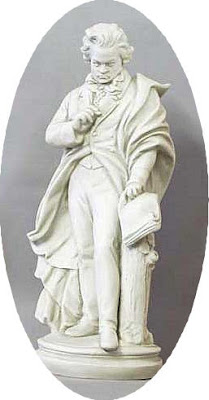Although Beethoven played the violin in the court opera orchestra in Bonn for four years in his youth and understood the complexities of writing for the instrument, he was far from a virtuoso. Historians think the violinist Franz Clement, the concertmaster and leader of the orchestra that played the first performances of Beethoven's opera Leonora (and also gave Beethoven some advice on) was Beethoven's go-to man for any technical help. How much (if any) assistance Beethoven needed is not known, but Clement was the soloist at the 1806 premiere of the concerto.
Tradition has it that the solo part wasn't finished in time for the performance and Clement had to sight-read parts of it at the performance itself. The concert was a benefit concert for Clement, and Beethoven himself conducted the concerto with Clement as soloist. The concerto was not a success, and wasn't heard again until 1844 when the 12 year-old violin prodigy Joseph Joachim revived it and played it with Felix Mendelssohn conducting the orchestra. Since then it has been a staple of the repertoire.
The concerto begins with a very long orchestral introduction, one of the longest orchestral beginnings of any concerto. A solo timpani taps five times in a rhythm which in typical Beethoven fashion returns in many guises throughout the movement. The violin finally enters, and remains in the spotlight for the rest of the movement. This first movement is one of the most expansive ones Beethoven ever wrote, and the lyrical violin writing may be a nod to the first soloist, because Clement was known for his lyrical style of performing. Beethoven left no cadenza, there have been many written by composer/violinists. The cadenza used in the present recording is by Fritz Kreisler.
The second movement remains lyrical in tone and consists of a gentle melody with some simple variations. The orchestra carries the melody while the violin day-dreams and carries on a running commentary. It is music of great peace, music that moves very gracefully and calmly. Time itself seems to slow down until the orchestra makes an outburst, and the solo violin escorts the finale's dance-like rondo tune. The violin part increases in difficulty and brilliance with each episode, until the cadenza and final statement of the theme.


No comments:
Post a Comment